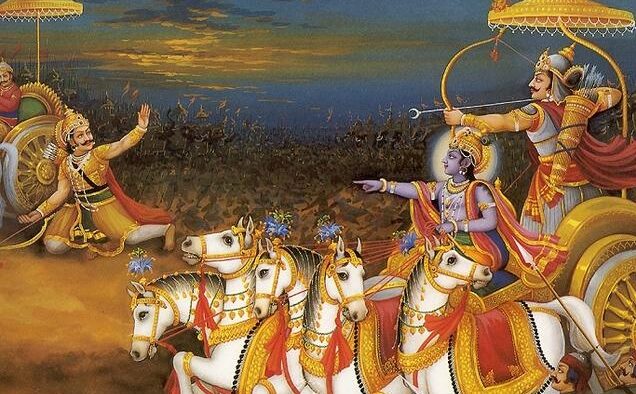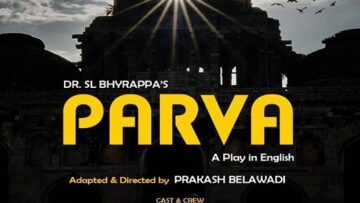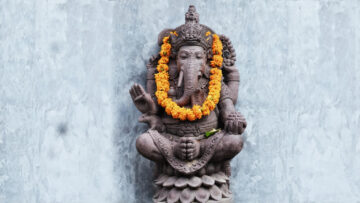In the Mahabharata, the most intriguing and disturbing characterization is that of Karna. It is also the one that has gone through maximum rewriting in this history of literature in India. Many other episodes and characters of Mahabharata went through rewriting only in the 20th Century. However, Karna has been reimagined very early in the post Vyasa Sanskrit literature as well as in other Bharateeya Bhashas. This reimagination has many concerns. Karna’s birth and his abandoning draws a natural sympathy. It is possible to reimagine and interpret a lot of his later situations based on that one incident where he seems to have suffered an irreparable loss. Yet, these reimaginations pale in front of the grand metaphor of Karna that Vyasa himself posits in front of us. The metaphor, meaning and the perspective can only be reclaimed in the backdrop of the Purushartha perspective and the Karma philosophy. For the purpose of this article, we shall assume that the readers largely know the story of Karna.
The key to Karna’s metaphor lies inside his birth itself. The young princess Kunti acquired a boon through her good service to the great Sage Durvasa. Tapascharya always results in extraordinary outcomes or powers. But it came a little too soon for Kunti. She was still young. At her age, wisdom did not get the better of curiosity. Every power is associated with an outcome. An extraordinary power with an extraordinary outcome. Kunti was at an age when extraordinary power was far more mesmerizing than the implications of its outcome. Kunti was not a lady of small stature. Kuntibhoja had brought her up in ways that she began to manage royal affairs at an early age. He chose her exclusively for this responsibility to serve Durvasa – something considered beyond the average and fraught with risks. Kunti walked through the responsibility successfully without putting her feet on any of the land-mine like risks. Unfortunately, she stepped on the only risk that came as a result of her success. Kunti invoked the Mantra that Durvasa presented, out of curiosity, with Surya as the Mantra-Devata. The rest is a story that everybody knows. Vyasa extends the metaphor. Once called, Surya cannot return without materializing the boon. Now with cold feet, Kunti is unwilling to go for the union. Surya uses all his charm to convince Kunti for the union. Kunti eventually consents. Thus was born Karna through the union of an unwilling Kunti and unrelenting Surya.
In his very birth, Vyasa has carved the foundational aspect of his metaphor. Karna was born out of the union of Tapascharya and Divya (divinity), mediated by curiosity and ahead of time. As a result, he was displaced or misplaced in time. Srishti serves the purpose of Dharma and hence Sthiti only when it is appropriate in space, time and context. Karna was born in the right space – the Kshatriyakula. But was out of place with respect to time and context. Born ahead and in a context that could not contain him within and nurture. irrespective of whether the palace would have sheltered Karna or not, Kunti herself was not prepared for it mentally, both as a person and as a princess, to be a mother in the society. As a result, the space could not contain and nurture Karna. His destabilization was more a result of Kunti’s state of mind than the physical context. Only Maharshi Vyasa can carve such a poignant metaphor. Kunti leaves the child in a basket (well protected) and lets it flow through the river (drifting). Thus, Karna began to drift even before acquiring his own feet on the ground before. Thus, it was a mindless flow rather than a definite flow. Hence, Karna never found his shores, he kept floating forever like that child in the basket – directionless and at the mercy of others. Metaphorically speaking, Karna never found the path of Ruta in his life. In Mahabharata, He is the epitome of the unstable dynamic without an equilibrium. (As an aside, Karna was called Vasushena until he gave away his Kundala to Indra, only after which he earned the name Karna. However, for the purposes of this article, let us refer to him throughout as Karna).
Thus Karna went afloat. Given the extent to which humanity depended on the river, Karna was certain to land shelter under somebody. To his luck, Karna reached the safe hands of a Soota – Adhiratha. Sootas were a community that lived close to royalty. They served as royal advisors or charioteers. The charioteers had a good status in the society as they played a key role in a war and were always close to the royals. The royalty entrusted them with significant responsibilities. As advisors they performed a variety of administrative functions. In addition, they had access to Kshatriya prowess. As it happened, Adhiratha was close to Dhritarashtra of the distant Hastinapura. Thus, Karna’s physical flow was full of luck. He landed up with a wealthy and elite family, who at that point did not have any children. Adhiradha and his wife Radha adored him from that point till his death. They knew that the boy was special with his Kavacha and Kundula. They named him as Vasushena – as one with divine wealth. Yet, his internal flow was one with instability that Karna could never come to terms with. The next thing that Vyasa mentions about Karna is that he was an integral part of Duryodhana’s attempts to eliminate the Pandavas, along with Shakuni and Dushyasana. Duryodhana consulted the other three in all such misdemeanours. Thus, the Dushtachatushaya was already in their formative years well before their royal-tutelage under Kripacharya. The drifting flow set by Kunti did not stop at Adhiratha. The charioteer father had given it his own dimension to the drift through his proximity with the Kuru royalty. But, Karna’s choice of cosying up with Duryodhana, though, was all his own.
Maharshi Vyasa packs a mighty amount of insight in this early journey of Karna. Karna’s flow is a combination of his divine birth, lack of a confident union (unwilling Kunti and reignless Surya), displacement initiated by Kunti and Adhiratha’s inability to contain him within his context. Karna’s eventual proximity with the Kuru royalty was a result of two factors. Tough displaced from his native context physically, but it remained as an element within him determining his drifting flow. But Adthiratha’s context was too weak to contain Karna’s brilliant elements. As a result, he reached the Kuru royalty much faster. Duryodhana must have perceived a special spark in him apart from his ambition, to make him an integral part of his conspiracies – even as he worried about Bheeshma and Vidura to come to know of it. Vyasa makes no mention of whether Karna excelled in skills that were part of the Soota ecosystem – which signifies the extent of displacement and destabilization that Karna suffered.
Thus, Karna was a Kshatriya among the Sootas and Soota among Kshatriyas. His innate elements sought the Kshatriya status but Karna never had the opportunity to go through the Kshatriya samskaras. On the other hand, Karna does not seem to have sought a grounding in the Soota Samskaras. Thus, a lack of grounding in anything seems to have affected Karna from the beginning. But Vyasa lays the responsibility to overcome the past absolutely on the individual, a fundamental tenet of the Karma perspective. One is alone responsible for investing in self realization. Crafting the right Karma for oneself is one’s own responsibility and the guiding principle ought to the Purushartha. If Kama (and Artha) alone are to be let free, as Karna did, it takes one to Duryodhana than Yudhisthira – even as both of them were available as choices to Karna equally. Karna chose Duryodhana and he alone was responsible for the choice.
The net result of everything – Karna was part of Duryodhana’s onsemble that learnt under Kripacharya. Realizing that Duryodhana was going wayward in his attempts to eliminate the Pandavas, Dhritarashtra and Bheeshma quickly put all the princes under Kripacharya. Duryodhana seems to have taken Karna along. When Dronacharya took over from Kripacharya, apart from the Kuru princes, royalty from all over the country came to learn under Dronacharya. Karna too sought Dhanurvidya from Drona, as was the norm with the Sootas, and joined the Gurukula. Vyasa mentions that from the day Karna joined the hatred between the Kauravas and the Pandavas increased. There was none to match Arjuna until Karna joined the Gurukula. Karna sought to match and compete with Arjuna. Nevertheless, Duryodhana and Karna made it a point to insult the Pandavas whenever there was an opportunity in the Gurukula. While he was cut above others to compete with Arjuna, never does Vyasa once mention that Karna matched Arjuna in anything. His innate Kshatra, the fire that was set by the union of Surya and Kunti, had its own blaze and radiance. The unsure Kunti represents that permanent imbalance in Karna that he could not ground it in the right ground.
Karna’s next appearance is in the display of Dhanurvidya prowess organized by Drona at the end of their terms in the Gurukula. Just as Arjuna completed his demonstration mesmerizing the entire audience, Karna signalled his arrival at the entrance with a thunder. He directly spoke to Arjuna and declared that he could demonstrate all the prowess that Arjuna demonstrated. [In this conversation, Karna presents a clear familiarity with the Kuru-Pandava ecosystem. That is natural as he was part of the Gurukula. It is only in the modern interpretations that Karna makes his remarkable first entry in this arena]. Arjuna goes through a dual emotion. On the one hand, he became angry at being challenged. At the same time, he felt humbled to see somebody claiming to equal him. Karna sought permission from Drona to demonstrate his prowess. Without any hesitation, Drona granted permission which too demonstrates that Karna was familiar to the ecosystem. Karna then performed every single feat that Arjuna did a little while ago – stunning the audiences into silence and cries of disbelief.
Duryodhana was never one to lose an opportunity. Right there, he embraced Karna and declared that he could live according to his will (Sveccha) in the Kuru Kingdom. In a society, where each was bound by the conventions of a community this freedom is very special. Thus Duryodhana elevated Karna’s status. He went a step further in hyperbole, declaring that he and his subjects would follow his orders. Karna’s response is remarkable. He sought Duryodhana’s friendship alone, indicating a continuation of existing relations. In addition, he sought a duel with Arjuna. So far Karna was an individual who he consulted and co-opted for specific purposes. Now, Duryodhana made Karna an equal. He introduced him to all his hundred brothers and to Ashwatthama as well – says Vyasa. Thus, Duryodhana had elevated him into an inner circle. The interactions between Karna and Duryodhana in this arena does not have any footprint of a first time interaction and is consistent with previous parts of the story where Duryodhana involved Karna in his misdemeanours.
Nevertheless, apart from this aside, Karna had, by then, marked competition with Arjuna as the destiny of his life. The conflict between his core elements of Kshatra which he derived from Kunti, dynamic which he derived from Surya and the ecosystem of Suta resulted in a significant confusion of Svadharma. His Kshatra took him to the Royalty of Hastinapura. But the destabilization of his birth did not enable him to manage the inner dynamic. Instead of flowing towards the Pandavas he kept drifting towards the Kauravas.
He had the element of Kshatra but without the Samskara. He had the element of divinity that had slipped in time and space. His own lack of investment in himself completed this triangle of deficiency. Karna failed to invest in himself beyond the physical prowess of archery. As a result, he ended up setting a lower target for himself. This Svadharma imbalance finally led to the Purushartha imbalance. In his Kama and Artha, he sought equality with Arjuna and let that get the better of everything else. He could not stretch it towards deeper investigation of why he was in this competition with Arjuna. He did not get any guidance (neither did he seek) to understand what drove the elements within him. Why was he ignoring the traditions of the Soota ecosystem in which he grew up? This never struck him at a fundamental level. The instability of his birth and the inability of the ecosystems to contain him set him in this path of constant competition with Arjuna. Thus, what should have been a flow became a drift. Soon that was to take him into a whirlpool.
Coming back to the arena, Arjuna chided Karna for having arrived without invitation and spoken without being sought. [Again, it is important to note that Arjuna does not ask who he was]. Such chastising would not discourage Karna though, he was not a small man. It is in the same Gurukula that he had acquired his prowess and knew enough Shastras. He defended his rights to enter and demonstrate his prowess. The Pandavas cheered Arjuna and Duryodhana encouraged Karna along with his brothers. Surya specially shone himself on Karna. It is at this stage that Kunti recognized Karna and went unconscious. An alert Vidura took her to the insides and informed servants to nurse her.
Kripacharya alone kept his calm and applied his mind. It is one thing to demonstrate prowess, it is another to get into a duel. The latter required the opponents to be equal in stature – for there all kinds of weapons that were involved. He sought to know from Karna his antecedents. As a Kshatriya, Arjuna could not end up fighting a non-Kshatriya. That would be Adharma and bring ignominy to Arjuna. A Kshatriya could fight a non-Kshatriya only if that is in a battle field. Karna’s face turned pale with embarrassment and a sense of loss. Yet again, Duryodhana stepped in (for he knew the reality from his association). He declared that apart from Kula – valour and the ability to lead an army are required to be considered a Kshatriya King. He praised Karna for possessing the two. However, if Arjuna were to fight only with a Kshatriya royal, Duryodhana declared that he would coronate Karna as the King of Anga Rajya. Interestingly, nobody objected to Karna challenging Arjuna. Not one objected to Karna demonstrating his prowess in the arena. When Duryodhana crowned Karna, let alone objections, the Kuru Sabha hailed Duryodhana and Karna.
The scene at the stage turned too soon. As Karna was being ‘granted’ the status of Kshatriya, the present caught up with Karna. In his fatherly love, Adhiratha stepped into the arena to hail Karna upon his coronation. Adhiratha as a charioteer friend of Dhritarashtra was quite well known. His ‘Suta’ status was equally well known. Not that the Sutas were any lesser. Many Kings were Suta-s. [Keechaka was a Suta from Gandhara region]. Traditionally, the Anga Kingdom belonged to the Sutas (as detailed elsewhere in Mahabharata) and by crowning Karna as the King of Anga, Duryodhana demonstrated a clear understanding of his background. By turning pale, it is Karna who demonstrated being ashamed of his Suta background. More than any rejection by others, Karna’s own lack of respect for his background emerges, primarily from the internal turmoil of Svadharma confusion (set about by the destabilized flow at the time of his birth). It is only Bheema who insulted Karna for being a Soota. Duryodhana made it worse by questioning the Pandava birth by Niyoga. He defended Karna fiercely. It is important to note that many royals and commoners continued to hail Duryodhana and Karna in the Sabha at this stage. Finally, the Sun set and the arena was brought to a halt.
Thus, Karna’s competition with Arjuna partially elevated him to the status of a Kshatriya but not yet equal to Arjuna. It was partial because it was granted only for the purpose of a duel and not one that was earned by Tapasya and Samskara. The story of the arena is a metaphor for the wrong path chosen by Karna once again. It represents haste, lack of clarity of destination and lack of Tapasya. Karna, though, had set his eyes only on that equality with Arjuna. In that, Karna drifted.
This drift continued, forever. Thus started a long journey where Karna simply could not come to terms with the force within his own self. He never found the clarity of his Svadharma. One may have a great force within. One may be born of divine elements. However, elements must be placed in the right container with constant nurturing. The Samskaras indicate that nurturing. Otherwise, one is not likely to find the grounding of Svadharma. An imbalance can only be set right through Tapasya. Karna had this option but he neither landed himself in the right hands for guidance nor did he himself have that clarity. Thus, the right Tapasya too was lacking.
Thus, born ahead of time, to an unwilling mother, the radiance and brilliance of Surya could neither be pulled back, nor be contained and placed well. Thus, the dynamic created a wander without a proper grounding and destination. That which moves without a sense of staying moves forever without a good purpose. It lives without the discretion of what is a good purpose for which it is worth being dynamic. Surya can shine the entire universe. It could burn when in excess, inadequately focused upon or incorrectly directed. Everything is required to be present in the right measure at the right time. An imbalance can drift towards a tragedy. It could still be set right with Tapasya, only if one recognizes and accepts the reality.
Karna’s life signifies this great tragedy.
Disclaimer: The opinions expressed in this article belong to the author. Indic Today is neither responsible nor liable for the accuracy, completeness, suitability, or validity of any information in the article.










